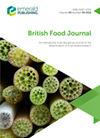Pasture shooting and mobile slaughterhouses from a consumer's point of view: alternative slaughter methods and the meat paradox
IF 3.4
3区 经济学
Q1 AGRICULTURAL ECONOMICS & POLICY
引用次数: 0
Abstract
PurposeThe purpose of this study is to investigate consumers' attitudes towards alternative slaughter methods (ASMs). ASMs present more animal-friendly and stress-free slaughter practices. However, these practices are not yet widespread due to strict regulations, high labor efforts and costs. Therefore, the market for meat products from ASMs is still small, and less is known about consumers' awareness, assessment and willingness to pay (WTP) for these products.Design/methodology/approachThis study aims to close the research gap using a standardized and representative online survey among 1,604 German participants. To identify target groups for these kinds of meat products, a factor and cluster analysis was conducted.FindingsThe results show that ASMs are not widely known among consumers. Overall, participants evaluated ASMs positively, but about 1/3 of the participants stated to also have concerns related more to hygiene than to animal welfare issues. The cluster analysis reveals two out of four clusters found that are interested in ASMs. These clusters are characterized by high trust in small butcheries and organic meat consumption.Originality/valueThe slaughtering sector has hardly been examined from an economic point of view in the animal welfare debate so far. This study identifies potential target groups for products originating from ASMs based on possible consumption drivers and barriers. Therewith, products from particular animal welfare friendly slaughter methods can be promoted purposefully to suitable target groups.从消费者的角度来看,牧场射击和移动屠宰场:替代屠宰方法和肉类悖论
目的本研究的目的是调查消费者对替代屠宰方法(asm)的态度。asm提供了对动物更友好和无压力的屠宰方法。然而,由于法规严格、人工成本高,这些做法尚未普及。因此,asm肉制品的市场仍然很小,消费者对这些产品的认知度、评估和支付意愿(WTP)了解较少。设计/方法/方法本研究旨在通过对1604名德国参与者进行标准化和具有代表性的在线调查来缩小研究差距。为了确定这些肉类产品的目标人群,进行了因子分析和聚类分析。研究结果表明,asm在消费者中并不广为人知。总的来说,参与者对asm的评价是积极的,但大约三分之一的参与者表示,他们更关心的是卫生问题,而不是动物福利问题。聚类分析显示,发现的四个聚类中有两个对asm感兴趣。这些集群的特点是对小型屠宰场和有机肉类消费的高度信任。到目前为止,在动物福利辩论中,屠宰部门几乎没有从经济角度进行过审查。本研究根据可能的消费驱动因素和障碍确定了asm产品的潜在目标群体。因此,特定动物福利友好屠宰方法的产品可以有目的地推广到合适的目标群体。
本文章由计算机程序翻译,如有差异,请以英文原文为准。
求助全文
约1分钟内获得全文
求助全文
来源期刊

British Food Journal
工程技术-食品科技
CiteScore
6.90
自引率
15.20%
发文量
219
审稿时长
18-36 weeks
期刊介绍:
After 115 years, the British Food Journal (BFJ) continues to be highly respected worldwide for its broad and unique interdisciplinary coverage of the latest food-related double blind peer-reviewed research. It links all sectors of this dynamic industry, keeping abreast of emerging trends, topical and controversial issues and informing and stimulating debate. - See more at: http://emeraldgrouppublishing.com/products/journals/journals.htm?id=bfj#sthash.O3wH4pEh.dpuf
 求助内容:
求助内容: 应助结果提醒方式:
应助结果提醒方式:


